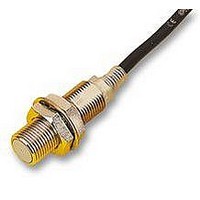E2EX10Y1 Omron, E2EX10Y1 Datasheet - Page 46

E2EX10Y1
Manufacturer Part Number
E2EX10Y1
Description
PROXIMITY SWITCH, M30, AC
Manufacturer
Omron
Datasheet
1.E2EX10Y1.pdf
(48 pages)
Specifications of E2EX10Y1
Svhc
No SVHC (15-Dec-2010)
Frequency Response Max
25Hz
Sensing Range Max
10mm
Sensor Input
Inductive
Supply Voltage Ac Max
240V
Approval Bodies
UL
External Length / Height
48mm
Ip/nema Rating
IP67
Lead Free Status / RoHS Status
Lead free / RoHS Compliant
E2E/E2E2
Environment
Water Resistivity
Do not use the Proximity Sensor underwater, outdoors, or in the
rain.
Connecting Load to AC/DC 2-wire Sensor
Refer to the following before using AC or DC 2-wire Proximity Sen-
sors.
Surge Protection
Although the Proximity Sensor has a surge absorption circuit, if
there is any machine that has a large surge current (e.g., a motor or
welding machine) near the Proximity Sensor, connect a surge ab-
sorber to the machine.
Leakage Current
When the Proximity Sensor is OFF, the Proximity Sensor has leak-
age current. Refer to pages 17 and 21 Leakage Current Character-
istics. In this case, the load is imposed with a small voltage and the
load may not be reset. Before using the Proximity Sensor, make
sure that this voltage is less than the load reset voltage. The AC
2-wire Proximity Sensor cannot be connected to any card-lift-off
relay (e.g., the G2A) because contact vibration of the relay will be
caused by the leakage current and the life of the relay will be short-
ened.
Countermeasures Against Leakage Current
AC 2-wire Models
Connect a bleeder resistor as the bypass for the leakage current so
that the current flowing into the load will be less than the load reset
current.
As shown in the following diagram, connect the bleeder resistor so
that the current flowing into the Proximity Sensor will be 10 mA mini-
mum and the residual voltage imposed on the load will be less than
the load reset voltage.
Refer to the following to calculate the bleeder resistance and the al-
lowable power of the bleeder resistor.
R x V
P > V
P: The allowable power of the bleeder resistor. (The actual power
I:
The following resistors are recommended.
100 VAC (supply voltage): A resistor with a resistance of 10 k max-
imum and an allowable power of 3 W minimum
200 VAC (supply voltage): A resistor with a resistance of 20 k max-
imum and an allowable power of 10 W minimum
If these resistors generate excessive heat, use a resistor with a re-
sistance of 10 k
mum at 100 VAC and a resistor with a resistance of 20 k maximum
and an allowable power of 10 W minimum at 200 VAC instead.
46
capacity of the bleeder resistor must be at least a few times as
large as the allowable power of the bleeder resistor.)
Load current (mA)
S
S
2
/(10 – I) (k )
/R (mW)
maximum and an allowable power of 5 W mini-
Bleeder resistor R
Load
VAC power
supply V
S
Operating Environment
Be sure to use the Proximity Sensor within its operating ambient
temperature range and do not use the Proximity Sensor outdoors so
that its reliability and life expectancy can be maintained. Although
the Proximity Sensor is water resistive, a cover to protect the Prox-
imity Sensor from water or water soluble machining oil is recom-
mended so that its reliability and life expectancy can be maintained.
Do not use the Proximity Sensor in an environment with chemical
gas (e.g., strong alkaline or acid gasses including nitric, chromic,
and concentrated sulfuric acid gases).
DC 2-wire Models
Connect a bleeder resistor as the bypass for the leakage current so
that the current flowing into the load will be less than the load reset
current.
Refer to the following to calculate the bleeder resistance and the al-
lowable power of the bleeder resistor.
R x V
P > V
P: The allowable power of the bleeder resistor. (The actual power
i
i
The following resistors are recommended.
12 VDC (supply voltage): A resistor with a resistance of 15 k maxi-
mum and an allowable power of 450 mW minimum
24 VDC (supply voltage): A resistor with a resistance of 30 k maxi-
mum and an allowable power of 0.1 W minimum
Inrush Current
A load that has a large inrush current (e.g., a lamp or motor) will
damage the Proximity Sensor, in which case connect the load to the
Proximity Sensor through a relay.
Connection to a PLC
Required Conditions
Connection to a PLC is possible if the specifications of the PLC and
the Proximity Sensor satisfy the following conditions. (The mean-
ings of the symbols are given below.)
R
OFF
: Leakage current of Sensors (mA)
1. The ON voltage of the PLC and the the residual voltage of the
2. The OFF current of the PLC and the the leakage current of the
3. The ON current of the PLC and the the control output (I
capacity of the bleeder resistor must be at least a few times as
large as the allowable power of the bleeder resistor.)
: Release current of load (mA)
S
Proximity Sensor must satisfy the following.
V
Proximity Sensor must satisfy the following.
I
(If the OFF current is not listed in the specifications, take it to
be 1.3 mA.)
the Proximity Sensor must satisfy the following.
I
The ON current of the PLC will vary, however, with the power
supply voltage and the input impedance used as shown in the
following equation.
I
S
2
OFF y
OUT(min)
ON
ON
/R (mW)
/(i
R
= V
x V
– i
I
CC
leak
OFF
CC
x I
– V
) (k )
– V
ON
R
R
– V
x I
PC
OUT(max)
)/R
Bleeder resistor R
IN
Load
E2E/E2E2
OUT
) of











